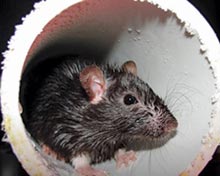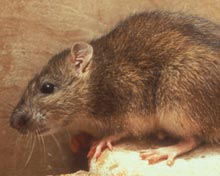
U.S. Center for Disease Control and Prevention

U.S. Center for Disease Control and Prevention
Norway Rat
General Description
The Norway rat (also called the brown rat or sewer rat) is a destructive pest found in urban and suburban
neighborhoods. These rodents eat and contaminate food, damage buildings and other property by gnawing and
burrowing, and can spread diseases that affect people and pets. Norway rats are husky, brownish rodents that
weigh about 11 ounces. They are about 13 to 18 inches long including the six to 8 1/2 inch tail. Their fur is coarse
and mostly brown, with scattered black on the upper surfaces. The underside is typically grey to yellowish-white.
Rats have litters of six to 12 pups, which are born 21 to 23 days after mating. Young rats reach reproductive maturity
in about three months. Breeding is most active in spring and fall. The average female has four to six litters
per year. Rats can live for up to 18 months, but most die before they are 1 year old.
General Control
Good sanitation will effectively limit the number of rats that can survive in and around a facility. This involves
good housekeeping, proper storage and handling of food materials and refuse, and elimination of rodent shelter
(harborage). Seal any openings larger than one-fourth of an inch to exclude both rats and mice. Openings where
utility conduits enter buildings should be sealed tightly with metal or concrete. Equip floor drains and sewer pipes
with tight-fitting grates having openings less than one-fourth of an inch in diameter. Doors, windows and screens
should fit tightly. Exclusion, sanitation, trapping and baiting are the most effective control methods. If there is a
repeated need for control, it is likely that sanitation and rodent-proofing should be improved.









